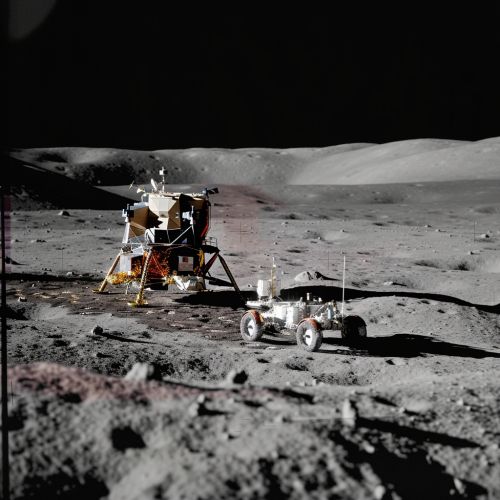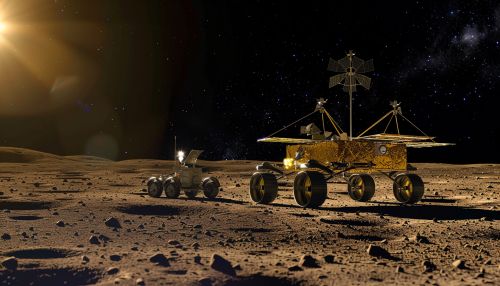Chang'e 4
Chang'e 4


The Chang'e 4 mission, part of the Chinese Lunar Exploration Program, represents a significant milestone in lunar exploration. Launched by the China National Space Administration (CNSA), Chang'e 4 was the first mission to achieve a soft landing on the far side of the Moon. This mission includes a lander and a rover, named Yutu-2, and has provided unprecedented insights into the lunar far side's geology, composition, and environment.
Mission Objectives
The primary objectives of the Chang'e 4 mission were to explore the far side of the Moon, conduct in-situ and remote sensing observations, and perform low-frequency radio astronomical observations. The mission aimed to study the lunar surface's topography and mineral composition, measure the neutron radiation and neutral atoms, and investigate the interaction between the solar wind and the lunar surface.
Spacecraft Design
The Chang'e 4 mission comprises two main components: the lander and the rover. The lander is equipped with a suite of scientific instruments, including a panoramic camera, a lunar penetrating radar, a visible and near-infrared imaging spectrometer, and a low-frequency radio spectrometer. The rover, Yutu-2, carries a panoramic camera, a lunar penetrating radar, and an advanced small analyzer for neutrals.
The lander and rover are powered by solar panels and are designed to withstand the harsh lunar environment, including extreme temperature variations and high levels of radiation. The mission also includes a relay satellite, Queqiao, positioned at the Earth-Moon L2 Lagrange point to facilitate communication between the lander, rover, and Earth.
Scientific Instruments and Experiments
The Chang'e 4 mission's scientific payload includes several sophisticated instruments designed to conduct a wide range of experiments:
- **Panoramic Camera (PCAM)**: Used for capturing high-resolution images of the lunar surface.
- **Lunar Penetrating Radar (LPR)**: Provides subsurface imaging to a depth of several meters, revealing the Moon's geological structure.
- **Visible and Near-Infrared Imaging Spectrometer (VNIS)**: Analyzes the mineral composition of the lunar surface.
- **Low-Frequency Radio Spectrometer (LFRS)**: Conducts low-frequency radio astronomical observations, taking advantage of the far side's radio-quiet environment.
- **Advanced Small Analyzer for Neutrals (ASAN)**: Measures the energy and flux of neutral atoms to study the interaction between the solar wind and the lunar surface.
Landing Site
The Chang'e 4 mission landed in the Von Kármán crater within the South Pole-Aitken Basin, one of the largest and oldest impact basins in the solar system. This site was chosen due to its scientific significance, as it provides an opportunity to study the Moon's far side's unique geological features and composition. The South Pole-Aitken Basin is believed to contain materials from the Moon's mantle, offering insights into the Moon's internal structure and thermal evolution.
Mission Achievements
Since its successful landing on January 3, 2019, Chang'e 4 has achieved several notable milestones:
- **First Soft Landing on the Far Side**: Chang'e 4 is the first mission to achieve a soft landing on the lunar far side, providing valuable data and images from this unexplored region.
- **Yutu-2 Rover's Longevity**: The Yutu-2 rover has exceeded its expected operational lifespan, continuing to explore and conduct scientific experiments on the lunar surface.
- **Discovery of Lunar Mantle Material**: Preliminary analyses of the data collected by VNIS suggest the presence of olivine and low-calcium pyroxene, which are believed to originate from the lunar mantle.
- **Low-Frequency Radio Observations**: The LFRS has conducted successful low-frequency radio observations, contributing to our understanding of the early universe and the solar system's formation.
Challenges and Solutions
The Chang'e 4 mission faced several challenges, including the harsh lunar environment, communication difficulties, and the need for autonomous operations. To address these challenges, CNSA implemented several innovative solutions:
- **Relay Satellite (Queqiao)**: Positioned at the Earth-Moon L2 Lagrange point, Queqiao facilitates communication between the lander, rover, and Earth, overcoming the direct communication limitations posed by the far side of the Moon.
- **Thermal Control System**: The lander and rover are equipped with advanced thermal control systems to maintain operational temperatures during the extreme lunar day and night cycles.
- **Autonomous Navigation and Operations**: The Yutu-2 rover is designed to operate autonomously, with advanced navigation and hazard avoidance systems to ensure safe and efficient exploration.
Future Prospects
The success of the Chang'e 4 mission has paved the way for future lunar exploration missions. CNSA plans to continue its lunar exploration program with the upcoming Chang'e 5 and Chang'e 6 missions, which aim to return lunar samples to Earth. Additionally, the insights gained from Chang'e 4 will inform the planning and execution of future missions to the Moon's far side and other celestial bodies.
